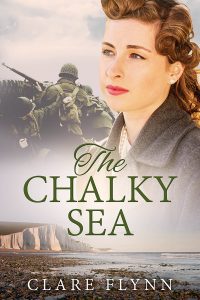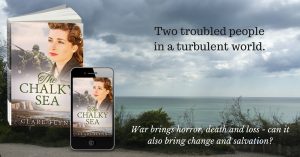The Inspiration for The Chalky Sea
 I live in Eastbourne, on the English Sussex coast. My family lived here when I was a schoolgirl and I decided to move back recently after twenty years in London. I have always had a hankering to move back to the sea. What I hadn’t expected was that the town had a secret wartime history.
I live in Eastbourne, on the English Sussex coast. My family lived here when I was a schoolgirl and I decided to move back recently after twenty years in London. I have always had a hankering to move back to the sea. What I hadn’t expected was that the town had a secret wartime history.
The Most heavily Raided Town in SE England
During my school days in the late sixties/ early seventies, no one spoke of Eastbourne in the Second World War. It was a surprise when I moved back and discovered that Eastbourne had once had the unfortunate claim to fame as “the most heavily raided town in south-east England”.
The evidence was under my nose – I just hadn’t spotted it. From the ugly 1960s extension tacked onto one end of the Edwardian Cavendish hotel, replacing the east wing bombed in May 1942 to the modern Central Library was opened in 1964 to replace the red brick structure that housed the original library and Technical Institute which was destroyed in 1943. There are post-war buildings dotted throughout the town including Marks & Spencer – bombed in December 1942, while people were doing their Christmas shopping, Barclays Bank (1943), and the central fire station (1943), St John’s church, Christ Church junior school, numerous shops, several hotels and pubs and four hundred and seventy four houses.
The air raids began in July 1940 and continued until March 1944. One hundred and ninety-nine people were killed – one hundred and seventy-two of them ordinary civilians, including several children. As well as being bombed out of their homes, the people of Eastbourne were strafed in the streets by machine-gun fire from the fighter-bombers. These statistics may seem small when compared with the loss of life sustained elsewhere, but they are extraordinary for a small holiday resort of no strategic importance.
A Valid Target?
To be fair, in 1940, Eastbourne was a valid target for Hitler. The early raids were doubtless intended to soften up the town ahead of the planned German invasion, Operation Sea Lion, which was to take place along the south coast and Eastbourne was at the likely centre of the invasion route. But the bombing didn’t stop when the invasion was called off.
Bombs were sometimes dumped on the return leg from London and the Midlands but more significantly, being just a short distance across the Channel, the town was the victim of “tip and run” raids. These involved bombers skimming low over the sea underneath the reach of the radar then, at the coast, climbing up over the chalk cliff of Beachy Head and swooping down on the town before zipping back across the Channel. These were purely designed to cause terror and damage civilian morale.
Canadians in Town
 I made another surprising discovery – the presence, between 1941 and the D-Day preparations of 1944, of thousands of Canadian soldiers. Their presence may have contributed to the town being a target. They took charge of coastal defences and were on exercises – scaling the chalk cliffs and manoeuvring tanks across the Downs to build up their readiness for eventual deployment at the front.
I made another surprising discovery – the presence, between 1941 and the D-Day preparations of 1944, of thousands of Canadian soldiers. Their presence may have contributed to the town being a target. They took charge of coastal defences and were on exercises – scaling the chalk cliffs and manoeuvring tanks across the Downs to build up their readiness for eventual deployment at the front.
With the heavy bombardment, which began a month before the London Blitz, the vast majority of the population evacuated, so that the local MP described the place as “Ghost Town on Sea”. The arrival of the Canadian army must have been welcomed by the pubs, cafes and retailers who remained open throughout the war. While women may have been thin on the ground, those that stayed in Eastbourne would never have lacked a partner at the popular Winter Garden dances. After the war, one hundred and fifty Eastbourne women went to Canada as war brides.
There was also loss of German life. The first “kill” over Eastbourne of a German fighter plane happened at the end of my road. A twin-engine Messerschmitt Me110 was shot down and crashed in the grounds of a school. The pilot, Hauptmann Ernst Hollekamp, already dead, landed on the roof of another school half a mile away, while his rear gunner parachuted into the sea and drowned.
The Challenge of Using Real Events
With all this wartime history on my doorstep, it was inevitable I would set a book here. Not part of the plan when I moved, within two months I started writing The Chalky Sea. The book is set mostly in Eastbourne, but also in Aldershot, and Ontario, Canada.
Writing fiction based on actual events requires one to be respectful to those involved while also being accurate. It is probable that relatives of victims of the bombings still live in Eastbourne. I used real bombings, but all the characters are fictitious. I stuck to the dates and places that were actually bombed, beginning with the first attack on the town in Whitley Road at 11.04 on July 7th 1940 – a Sunday morning. If people die in The Chalky Sea, then people actually died in that raid at the time. Sadly with so many raids there was no need for invention.
The Chalky Sea follows two main characters – Gwen an Eastbourne woman, alone and refusing to evacuate the town after the departure of her officer husband to an unknown destination for what we now know as Special Operations; and Jim, a young Canadian farmer, who joins up in a fatalistic effort to escape from a broken heart. The Chalky Sea follows their individual journeys and examines the impact of war on them and how it changes each of them profoundly.
—
Born in Liverpool, historical novelist, Clare Flynn writes historical fiction with a strong sense of time and place and compelling characters. After a career in international marketing, working on brands from nappies to tinned tuna and living in Paris, Milan, Brussels and Sydney, she ran her own company for 15 years and now lives in Eastbourne where she writes full-time – and can look out of her window and see the sea.
When not writing and reading, Clare loves to paint with watercolours and grabs any available opportunity to travel – sometimes under the guise of research.
https://www.facebook.com/authorclareflynn/
About THE CHALKY SEA
Two troubled people struggle to find their way in a turbulent world.
In July 1940, Gwen Collingwood drops her husband at the railway station, knowing she may never see him again. Two days later her humdrum world is torn apart when the sleepy English seaside town where she lives is subjected to the first of many heavy bombing attacks.
In Ontario, Canada, Jim Armstrong is debating whether to volunteer. His decision becomes clear when he uncovers the secret his fiancée has been keeping from him. A few weeks later he is on a ship bound for England.
Gwen is forced to confront the truth she has concealed about her past and her own feelings. Jim battles with a bewildering and hostile world far removed from the cosy life of his Canadian farm. War brings horror and loss to each of them – can it also bring change and salvation?
Category: Contemporary Women Writers, On Writing
























